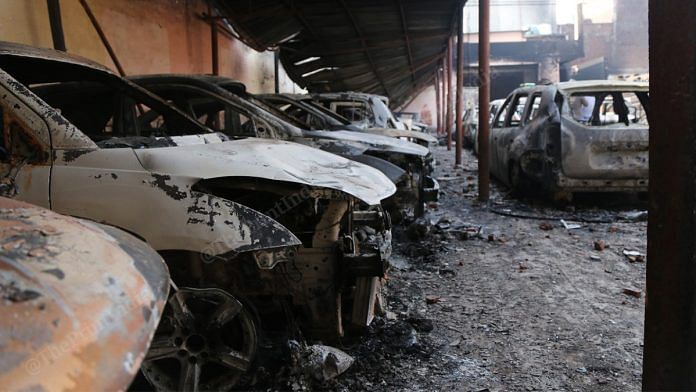New Delhi: The charge sheet in the killing of head constable Ratan Lal and alleged injuries suffered by two police officers during the Delhi riots didn’t include “crucial” documents, which has now led to charges of “fabrication” of evidence.
The charge sheet, a copy of which has been accessed by ThePrint, didn’t specify the nature of alleged injuries on the officers — Amit Sharma, Deputy Commissioner of Police, Shahdara, and Anuj Kumar, Assistant Commissioner of Police, Gokulpuri.
Legal experts say this detail is important in criminal cases to determine the charges against the defendants.
Mehmood Pracha, who is the defence counsel for six accused, has alleged this indicates that the Delhi Police is “fabricating evidence” in order to fill up the “lacunae” in the case.
On Wednesday, Pracha withdrew the bail application in the case from a local court, arguing that its bail hearing arguments were used to fill up the lacunae.
The charge sheet pertains to the alleged injuries suffered by Sharma and Kumar, who were leading the Delhi Police on 24 February in the middle of riots in Northeast Delhi. While the two officers were injured, Lal was killed.
Seventeen men from the area were arrested in the case in April and May. Out of these, Pracha is representing six men, who have been booked for assault of public servant and attempt to murder, among other charges, under the Indian Penal Code and the Prevention of Damage to Public Property (PDPP) Act.
ThePrint reached Delhi Police Commissioner S.N. Shrivastava, Crime Branch special commissioner Praveer Ranjan and DCP (Crime) Joy Tirkey for a comment via calls and texts, but there was no response until the time of publishing this report.
A police source told ThePrint, “Identifying evidence and investigating details takes time, especially in a riots case. An investigation continues well after filing the initial charge sheet. This does not amount to filling up lacunae.”
Also read: Delhi govt counsel’s non-communication with police benefiting riot-accused, says DCP
What was missed in the charge sheet
According to the charge sheet filed on 8 June, the documents from the government-run Guru Teg Bahadur (GTB) Hospital — one of the primary hospitals administering treatment during the February riots — did not comment on the “nature” of the injuries.
The GTB Hospital’s Medico Legal Certificates (MLCs) for both the officers read “absconded from casualty”.
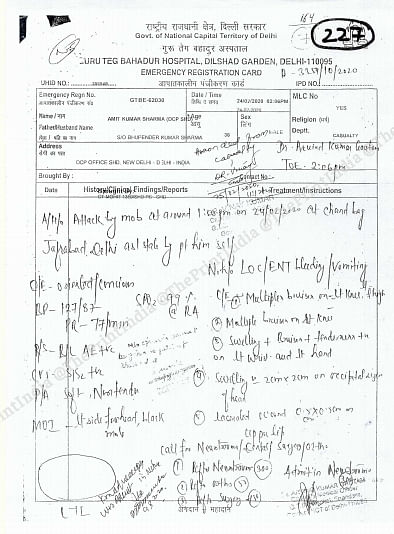
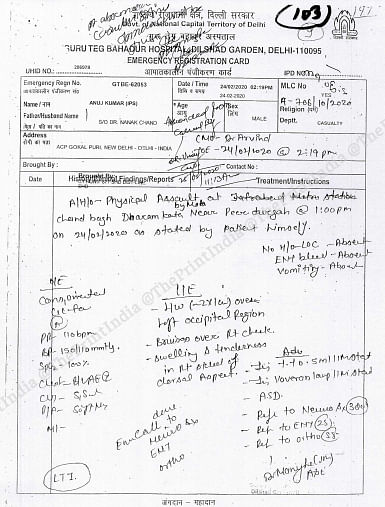
The charge sheet also included documents from the private Max Hospital, which mentioned the findings of the physical examinations conducted on the two officers, but did not categorically state whether the injuries were “simple” or “grievous” in nature.
Legal experts say this is an important requirement in all criminal case charge sheets.
“In a criminal trial, it is crucial for the MLC mentioned in the charge sheet to specify the nature of the injury. It needs to be categorically stated,” criminal lawyer Ajay Verma told ThePrint. “It is based on the nature of the injury that the judge will ascertain whether the charges against the accused are appropriate or not.”
Also read: Pinjra Tod’s Devangana Kalita gets bail in Delhi riots case, HC says she protested peacefully
The ‘lacunae’
Advocate Mehmood Pracha moved the bail plea for his clients on 18 June. In the bail hearings that took place subsequently, Pracha pointed to the absence of “nature of injuries” in the charge sheet.
However, soon after he pointed out this “lacunae” in the charge sheet, the Delhi Police filed a supplementary charge sheet on 30 June. This included medical certificates from Max Hospital — one for Sharma saying he suffered grievous or “dangerous type of injury”, and another for Kumar, terming his injury “simple”.
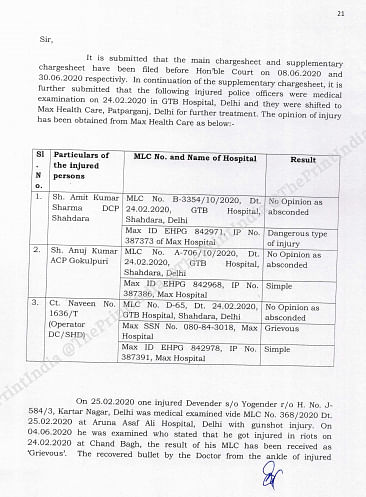
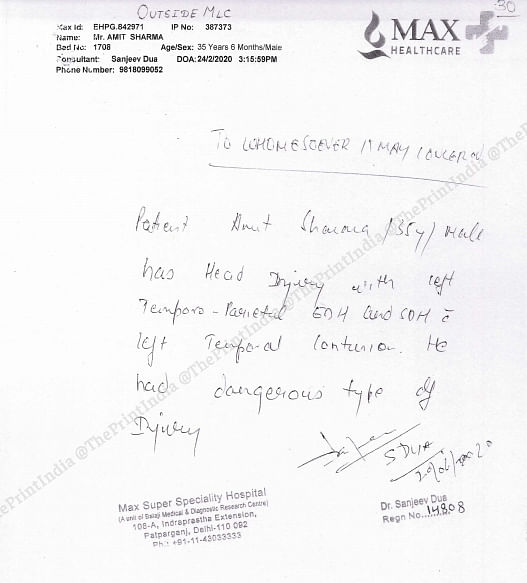
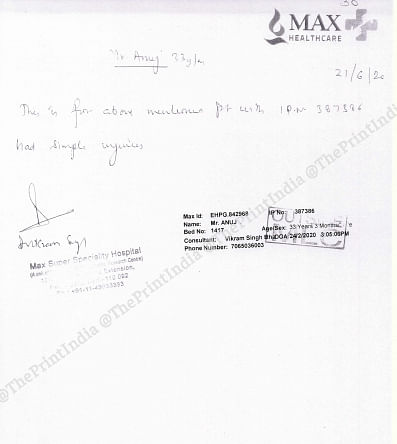
The certificates were dated 20 June (for Sharma) and 21 June (for Kumar) — nearly four months after the riots.
While the certificates specified the date of admission of the two as 24 February, the defence objected to their issuance after four months. It subsequently claimed that its bail hearing arguments were being used to fill these gaps.
“The certificates specifying the nature of injury were missing and were conveniently brought forth after we pointed it out, that too from a private hospital. This shows the evidence was fabricated in order to fill the glaring lacunae,” Pracha told ThePrint.
On 31 August, Pracha made a submission in the court, arguing that “the police has sought to plug-in the lacunas in the matter pointed out by him, by filing two supplementary charge sheets”.
In his submission, Pracha also said that “if he advances further arguments in the matter, then the police may come up with a third supplementary charge sheet to cover up” the arguments.
However, the investigating officer of the case, Inspector Gurmeet Singh, responded to the accusations in the court saying “there were several rioters, whose identification is still going on by analysis of dump data and video footages”.
“All these will have to be placed on record by way of supplementary chargesheet and not as a measure of plugging-in lacuna,” the officer added.
However, lawyer Verma said, “If the nature of injuries were missing in the MLC attached with the first charge sheet, but only added later after the defence pointed it out, it creates suspicion and doubt in the investigation.”
Also read: Delhi assembly panel wants Facebook named co-accused in communal riots, hints at ‘conspiracy’
Withdrawing bail plea
On Wednesday, Pracha withdrew the bail application, pending since 18 June, saying the accused “find it a better option to wait patiently for the investigation to be completed and then press their bail applications”.
The submission said the accused sought bail in the case “but the subsequent events have left them facing a choice between either suffer continued incarceration or to point out the shortcomings in the charge sheet and risk allowing the investigating agency to cover up the lacunas so pointed out”.
In response to these allegations, the Delhi Police argued there is “no bar in law against the investigating agency to further investigate the matter after filing of the chargesheet and supplementary chargesheets”.
“The right of the investigating agency to investigate the case can not be curtailed by filing such application,” it said.
What the court said
The court allowed the defence to withdraw its bail application saying it “can not permit a roving/fishing inquiry during the judicial proceedings in this matter as sought to be done through this application”.
“The reports of the injured witnesses were received after the filing of chargesheet in the matter. Similarly, there are several reports which are still awaited and those will also be placed on record by way of supplementary chargesheet,” the judge said in the court order. ThePrint has seen a copy of it.
The order added that “riot cases can not be equated with other criminal cases where the accused and victims stand clearly identified and the police just has to collect evidence against the accused”.
“In riot cases, the police has to first obtain CCTV footage or video footage of the incident and then identify the persons present at the scene of crime and it is very difficult to clearly identify each and every person in one go and investigate the matter,” it said.
Also read: New book blaming ‘radical’ Islamic groups for Delhi riots to hit stands after Bloomsbury row


